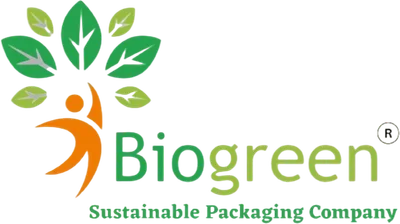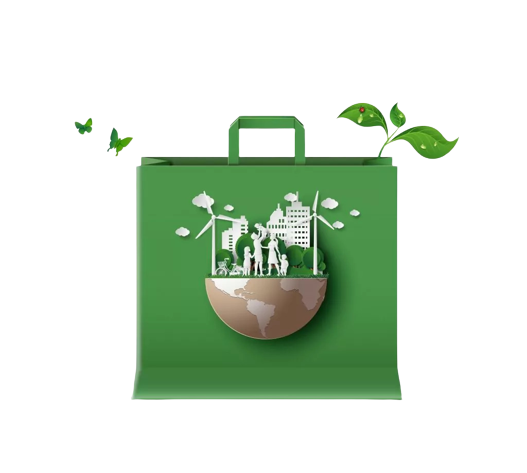Introduction
The world of packaging is changing extremely rapidly, and plant-based packaging is the new face of the previous plastics. PLA (Polylactic Acid) and PBAT (Polybutylene Adipate Terephthalate) are two of the most widely used biodegradable packaging materials. Both are utilized to produce products such as biodegradable carry bags and compostable bubble wrap, but is either of them ideal to be utilized for packaging? Let us learn about it in easy words.
What is PLA (Polylactic Acid)?
PLA is a bioplastic produced from renewable crops such as cornstarch or sugarcane. PLA is utilized in food packaging, bottles, and bags that biodegrade in the environment. The best thing about PLA is that it is produced from plants, which is greener than plastic produced from oil.
What is PBAT (Polybutylene Adipate Terephthalate)?
PBAT is a petroleum-based biodegradable plastic that functions almost identically to regular plastic. It is hard, stretchy, and usually mixed with PLA for extra hardness. PBAT can be used in most of the packing materials, such as compostable trash bags and biodegradable dog poop bags, where the primary needs are elasticity and hardness.
Key Differences Between PLA and PBAT
| Factor | PLA (Polylactic Acid) | PBAT (Polybutylene Adipate Terephthalate) |
|---|---|---|
| Source | Made from renewable plant-based resources (corn, sugarcane) | Petroleum-based, but still biodegradable |
| Strength | Strong and rigid but brittle | Flexible and durable |
| Degradation | Requires industrial composting to fully degrade | Breaks down faster under composting |
| Applications | Rigid packaging, disposable tableware, 3D printing | Compostable bags, films, flexible packaging |
| Cost | Generally lower | Slightly higher |
Advantages of PLA for Packaging
Composed of renewable materials.
Transparent and good for food packaging.
Light and can be easily moulded.
Used in products like clothing, compost bags that need to be organized and concise.
PLA is an excellent choice for companies requiring packaging that is both attractive and eco-friendly.
Advantages of PBAT for Packaging
High flexibility and durability.
It is suitable for elastic bags and thin films. Typically blended with PLA for enhanced performance.
Applied predominantly in wraps such as compostable and biodegradable cling wrap and stretch films.
PBAT is a suitable package material that has to be pressure-resistant, just like biodegradable stretch film used in pallet wrapping and shipping.
Limitations of PLA and PBAT
Both are environmentally friendly, but both have drawbacks:
PLA: Brittle, heat-resistant, and compostable primarily in an industrial setting.
PBAT: Petroleum-based, hence not renewable to some degree.
Both are more earth-friendly than regular plastic. Just as biodegradable carry bags are an eco-friendlier choice at the supermarket than plastic, these polymers are an earth-friendly choice as well.
Which Polymer is More Suitable for Packaging Products?
The selection between PLA and PBAT will be based on the packaging form
If you require a tough and biodegradable plastic, utilize PLA.
If you need a strong and flexible material → PBAT is better.
All of them use a combination of PLA and PBAT to produce durable and biodegradable packaging.
For example, PLA is found to be better for food packaging, while PBAT is found to be better for flexible packaging bags and wraps, e.g., biodegradable bubble wrap or delivery packaging.
Conclusion
PLA and PBAT are both great choices for green packaging. PLA breaks down naturally and can be used for hard packaging, whereas PBAT is rigid and flexible. They are used to replace harmful plastics with harmless ones like compostable trash bags, biodegradable dog poop bags, and compostable shopping bags.
By using packaging that is produced from PLA or PBAT, houses and companies can reduce the use of plastic and contribute towards a cleaner, healthier world.
Frequently Asked Questions (FAQs)
Q1. Is PLA greener than PBAT?
Ans. Yes, PLA is plant-based while PBAT is oil-based. PBAT renders products flexible, which PLA does not.
Q2. Are PLA and PBAT compatible with each other?
Ans. In fact, this blend is also employed extensively in biodegradable courier bags that are biodegradable.
Q3. Which industries utilize the largest amounts of PLA and PBAT?
Ans. Food packaging, food delivery, product-selling stores (e.g., compostable grocery bags and compostable garment bags), and online shopping.
Q4. Can PLA and PBAT be composted at home?
Ans. They primarily require industrial composting, but some are attempting to make forms compostable at home.
Q5. Can PLA and PBAT packaging materials be purchased?
Ans. They can be sourced from environmentally friendly packaging companies, online stores, and product-selling companies, such as biodegradable cling film and biodegradable stretch film.


